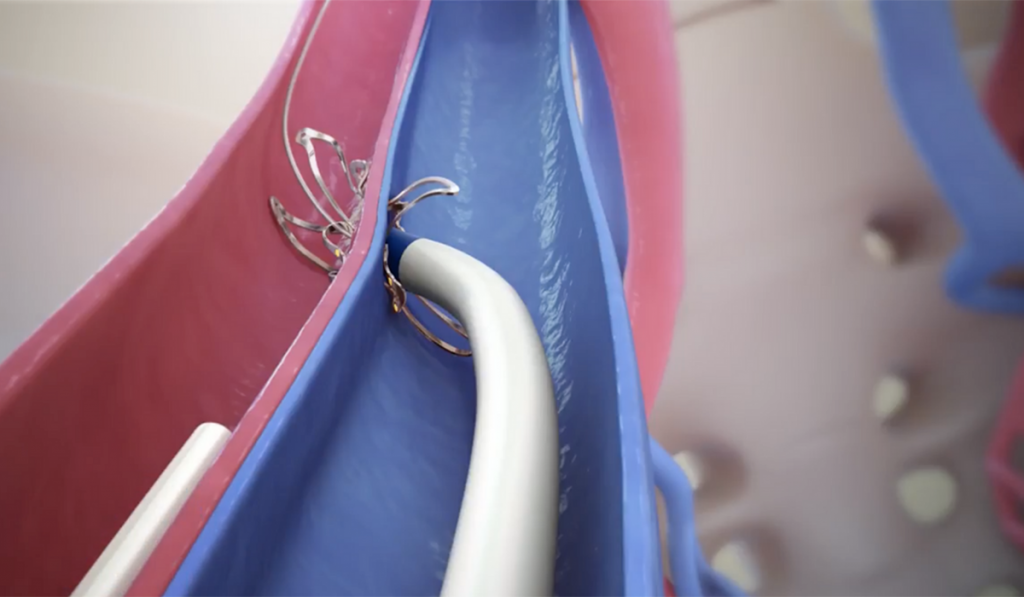Iliac arteriovenous anastomosis — mechanically reducing BP by adding a low-resistance, high-compliance segment to the central arterial tree — is a promising adjunctive therapy for drug-resistant hypertension. In one prospective, randomized, multi-site European trial, a novel arteriovenous coupler device, the ROX Coupler (ROX Medical, San Clemente, CA, USA), demonstrated a significantly greater ability to lower BP in coupler device recipients over a control group using medications only.1
“The original ROX Control Hypertension trial, reported in Lancet, showed about a 27-point drop in systolic blood pressure at six months. But in reality, that drop in pressure occurred almost immediately in the catheterization lab,” said Pete Fong, M.D., a specialist in interventional cardiology and peripheral vascular disease at Vanderbilt University Medical Center.
Jay Gainer, M.D., a hypertension specialist at Vanderbilt, is excited about the ROX Coupler’s potential to reduce cardiovascular risk in a non-pharmacologic fashion: “The magnitude, reproducibility and sustainability of the BP drop observed with the ROX Coupler therapy distinguish it from other device-based modalities,” Gainer said.
Vanderbilt is participating in a new, multi-site, U.S. trial of the ROX Coupler, which is not yet FDA approved. The CONTROL HTN-2 study will include a sham control and will evaluate change in mean 24-hour ambulatory systolic BP at six months as the primary outcome measure. The study is currently recruiting eligible participants.2
Mechanism: Central Arteriovenous Anastomosis to Treat Uncontrolled HTN
The ROX Coupler is a stent-like, nitinol device with shape memory to self-expand on deployment. When placed using femoral vein and arterial access, the coupler may help lower BP by decreasing total volume of blood in the arterial circulation, thereby decreasing peripheral vascular resistance.
“After we access the femoral artery and vein, the device is routed through the external iliac vein into the external iliac artery. One side of the ROX Coupler is deployed in the artery and the other side in the vein. Once the coupler is deployed, an anastomosis has been made between the artery and the vein. Essentially, we are forming a small 4mm AV fistula,” said Fong.
“In addition to decreasing volume in the arterial system, research indicates a decrease in arterial stiffness, which is more common in the elderly,” Fong said. “Both mechanisms appear to help lower blood pressure in an immediate and sustained manner.”
As part of the study protocol, participants at Vanderbilt who undergo randomization will also receive a right heart catheterization. The catheterization will help safely restrict patients with elevated pulmonary arterial and wedge pressures caused by the device.
The study protocol also includes vascular studies before and after the procedure, and patients will have follow-up visits several times throughout the first year. “Prior studies have shown that some patients will have lower extremity edema due to increased volume entering the venous side. The protocol also allows for interventions to relieve venous stenosis if indicated,” said Fong.
Mechanical-Vascular Approaches: Next Steps
“Device trials in the field of hypertension have been relatively few. But we feel these devices are promising for reducing pharmacologic dependence for hypertension control.”
Fong believes the ROX Coupler therapy could eventually be extended to other patients who are intolerant of antihypertensives due to side effects. In addition, some patients may seek out mechanical approaches to lowering BP hope in order to come off their medications permanently, or at least decrease dosages.
“It’s understandable that the FDA wants to be rigorous about approving the right device,” Fong said. “The potential number of patients qualifying for this type of mechanical therapy is quite large.”
“Device trials in the field of hypertension have been relatively few,” said Gainer. “But we feel these devices are promising for reducing pharmacologic dependence for hypertension control.”
Vanderbilt is currently enrolling in three multi-center trials, including CONTROL HTN-2, that employ mechanical approaches to treat HTN. Referral information for the CONTROL HTN-2 trial is available from ROX Medical at controlbp.com. Referrals to the Vanderbilt site can be directed to (615) 322-2318.






